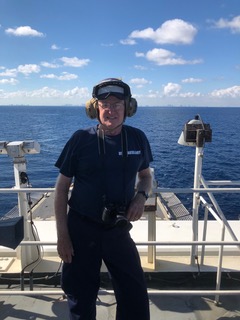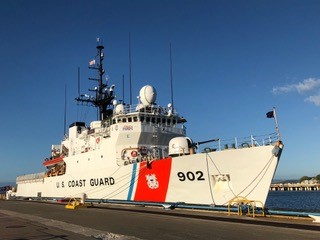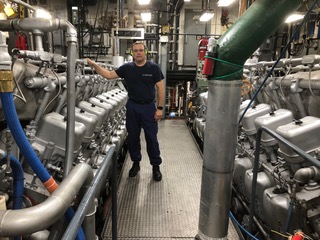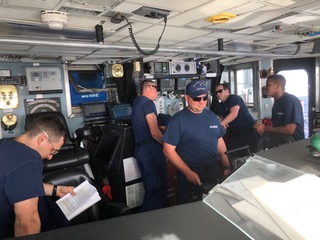An Auxiliarist Goes Back to Sea
As an auxiliarist who had been on active duty in the Coast Guard, and served for three years aboard
 cutters, I never thought that I would get the opportunity to again serve aboard a cutter on patrol. As they say, “Never say never”, because you don’t know what the future will bring.
cutters, I never thought that I would get the opportunity to again serve aboard a cutter on patrol. As they say, “Never say never”, because you don’t know what the future will bring.In mid-December I received a phone call from our District Captain, Alan Fredd, asking if I would like to deploy TDY on the USCGC TAMPA for 30 days on a patrol in the Caribbean Sea. The ship was scheduled to depart Portsmouth, VA on 16 December, and we would be flown home from San Juan, P.R. on January 12th. I would be joining two other auxiliarists from District 5, Southern Region. Since this would take me away from home over the Christmas and New Years’ holidays I conferred with my wife and she said it was my decision. I realized that since this would be a once in a lifetime opportunity, I accepted the offer.
I was to replace another auxiliarist who had committed to the trip but family issues dictated that he needed to cancel. I had about 3 days to prepare for this deployment, and make sure that I had enough ODU’s and gear for the month aboard TAMPA. On Friday, 15 December, 2017, I headed to Portsmouth, VA to report aboard the TAMPA.
The TAMPA is a 270’ Medium Endurance Cutter with a complement of about 100 officers and crew. The
 make-up is about 14 officers and 86 enlisted. The ship has a flight deck and Hangar, and on some patrols will deploy with an MH-65 Helicopter. The 270’ class of cutters is known as a “lively” class of ship as they are known to ‘rock & roll’ a bit more than any of the other classes of ships!
make-up is about 14 officers and 86 enlisted. The ship has a flight deck and Hangar, and on some patrols will deploy with an MH-65 Helicopter. The 270’ class of cutters is known as a “lively” class of ship as they are known to ‘rock & roll’ a bit more than any of the other classes of ships! Many auxiliarists are aware of what duty at a lifeboat station is like, and some are even familiar with the larger bases such as Portsmouth or Yorktown.
Many of us are qualified to stand comms watches, cook meals, and even help with routine maintenance at these stations. That being said, I also believe that the vast majority of auxiliarists really have no idea of what life and duty aboard a large cutter is like. The reason for this report is to try and acquaint our members with what life is like on board ship, with the hope that more of us would elect to spend some time on a ship should that opportunity once again present itself.
The Commanding Officer of TAMPA, CDR Nick Simmons, and the XO, CDR Anne O’Connell had requested three auxiliarists to deploy TDY for the first month of their 90 day patrol. The idea was to familiarize auxiliarists with shipboard operations, and even get them qualified as watchstanders wherever possible so that they might actually be able to work into the watch schedule.
More on that later.
For those of us that might be interested in going to sea on a cutter, I am going to do my best to describe what daily life is like on board. On a ship at sea, life is much more “structured” than it is on a shore station. For example, there are watches that are stood 24/7 on the bridge and in the engine room. On the bridge there is an OOD (Officer of the Deck) with possibly a new officer “breaking in” as an OOD; a QMOW, i.e., a Quartermaster Of the Watch, which is a Boatswains Mate who specializes in navigation; a helmsman and lookout who are “non-rates”, (an E-2 or E-3 which is a Seaman Apprentice or Seaman First Class). There is also a possibility of having additional personnel who are “breaking in” as QMOW or helmsmen/lookouts. The bridge can get a bit crowded if all of these personnel are on watch.
The engine room will have an EOW or Engineering Officer of the Watch who also might have a junior
 officer “breaking in” as well, and also 2 “non-rates” who keep track of the various pressures, temperatures, quantities and readings of the equipment under their control.
officer “breaking in” as well, and also 2 “non-rates” who keep track of the various pressures, temperatures, quantities and readings of the equipment under their control. The ship’s crew is divided into four Divisions: Deck, Operations, Engineering and Support. The Deck Division consists of the Boatswains and Non-Rates; Operations isGunners Mates, Operations Specialists, Electronics Technicians and Information Technology Specialists; Engineering contains the MachineryTechnicians, Electricians Mates, and Damage Control Specialists; Support Division contains the Culinary Specialists, Health Services Technician, Yeomen and Storekeepers.
We three auxuliarists spent our time between the bridge and the engine room with the intent of getting us qualified in one or more areas. We were partially successful in that endeavor and more on that later in this article.
Another issue is the obvious one of the deck not being steady. Ashore, the deck does not move. It’s a whole other thing underway! The deck underway is NEVER steady. Even on a beautiful calm day the deck will roll and pitch to some degree and in rougher seas it is indeed a tough job to simply stay on your feet. If you are truly going to be a ‘sailor’, you should know the nomenclature: The ‘floor’ is a deck, the ‘walls ‘ are bulkheads, the ‘ceiling’ is an overhead, the access between the decks are hatches. Many of the doors are watertight doors and some are kept closed and ‘dogged down’ all the time.
The average age of an auxiliarist is about 63 years of age and an important fact to consider is that there are numerous ladders (NOT Stairs) that must be negotiated many times throughout the day. For example, P.J. O’Neill, the other male auxiliarist with me, and I were given bunks in the Senior Petty Officer berthing which was one deck below the main deck. Our third auxiliaristwas Patricia Elderidge, and she was assigned a berth inthe female berthing areawhich is also one deck below the main deck. In order to get to the bridge where we stood our watches, we had to climb four (4) ladders several times a day. For the first week my 76 year oldlegs were NOT happy! They did toughen up however and the last 3 weeks were fine, but as you can see, it is something to consider if you would like to go to sea. You really need to be in good physical shape and relatively agile!
So, let’s say that you would like to go to sea and are actually chosen to go. You want to know what the “daily routine” aboard the ship is like, right? So, let’s start our day!
At 0730 breakfast is served. Initially it is for Chiefs and watchstanders, with watchstanders at the head of the line. At 0745 breakfast is for “all hands”. Officers and crew go through the same “chow line”. The meals were exceptionally good. We had all manner of wonderful meals, from lobster tails to prime rib and even ‘surf & turf’. After breakfast, the office personnel start their day, and other Divisions’ personnel who are not on watch will go to their respective work stations or shops/offices.
At 1000 reveille is ‘piped’ throughout the ship and those who had the “midwatch” (0000 to 0400) are awakened to start their day also. There are no ‘pipes’ made prior to 1000 to let those who had the mid-watch get some undisturbed sleep.
At 1130 the noon meal is ‘piped’ and again it is for the Chiefs and watchstanders, followed at 1145 for ‘all hands’. On 2 days during the week Muster is held after the noon meal and the ships’ XO announces important information, and other crew members who have messages for the crew are given the opportunity to “spread the word”. It was at this first muster at sea that we three auxiliarists were formally “introduced” to the crew, since they were very interested in just who these three new “older” crew members were! At my age there was NO WAY that I could just blend in with crew whose average age was that of my grandkids! CDR O’Connell presented each of us with a TAMPA ball cap to show that we were considered part of the crew.
At 1730, the evening meal is ‘piped’ with same format as the other two meals and after dinner the crew hastime off to read and relax. Several groups were playing board games, cards, and others were watching movies or TV shows in their respective ‘lounges’.
The ship’s IT-1, Joe Hayes, had downloaded a few hundred movies as well as dozens of TV series episodes for the crew to watch and there is a large screen TV in each berthing area lounge and 2 more on the mess deck (dining area), and one in the wardroom.
A very important activity that receives constant attention is Training and Drills! Every time the ship heads out to sea on patrol there are a number of new personnel on their first trip at sea. Some are fresh out of Boot Camp, or “A” School, and they must quickly learn their responsibilities for all of the normal as well as emergency situations that might be encountered. CDR Simmons stated that in the 7 months he had command, he had 53 new crewmembers report aboard. The ships normal complement is about 100 so that’s 53% of his crew that needed to be trained. The mess deck is usually used as the classroom and there are 2 large-screen TV’s to use for audio-visual material.

After the noon meal, and muster, the ship is put into a “Training Environment”, and at any time after that you cuould hear an announcement of some emergency situation and all hands not on watch must proceed to their duty stations and handle the emergency. These training scenarios are practiced Monday through Friday. Since we Auxiliarists did not have a duty billet for these evolutions, we became the ‘casualties’ so the ships crew could practice their first aid skills.
During our time aboard we observed Flight Ops with a Helicopter from USCG Air Station Miami, which gave the crew the chance to train in a ‘real world’ environment. Bringing a helicopter aboard is a potentially dangerous evolution as the ships’ deck is in constant motion. The evolution continued all afternoon and then resumed after sunset for night operations. By 2030 all had trained to proficiency and after a final refueling the helicopter departed TAMPA and headed back to Miami.
TAMPA also handled the transport of “detainees” from a Fast Response Cutter off Puerto Rico, and the transport of 51 bales of pure cocaine. During one of the training days I also got to ride on the ship’s OTH Boat (Over The Horizon) during the QE ride for a crewman who was getting qualified for Boat Crew. I was warned that I would get wet, but I didn’t realize that they meant WET!! Great fun, even if I did get soaked!!
On Saturday mornings, the crew holds a “Field Day”, which is the term used for cleaning of the living spaces. Sweep up, swab the decks and clean the ‘heads’. After the noon meal on Saturday, the ship enters a “Holiday Routine” which means free time and rest. Sundays are Holiday Routine all day.
Monday through Saturday at 1900, non-denominational evening devotionals were held in the wardroom, led by CWO4 Donnie Boyer, the MPA (Main Propulsion Assistant) and on Sunday mornings at 1100 he led an hour of non-denominational religious service. These services are strictly voluntary and several crewmembers participated.
One other point that I need to make is this: If an auxiliarist goes aboard with no prior military experience, it behooves that individual to sit down with someone who has had prior military experience, preferably Navy or Coast Guard, and review military shipboard protocols and courtesies. Even though we were berthed with Senior Petty Officers, we were invited to take our meals in the wardroom with the ship’s officers and there are do’s and don’ts and courtesies that one needs to be aware of. If the auxiliarist has not been exposed to life aboard ship with a full complement of officers, especially senior officers, it would be the smart thing to do.
Finally, as to having the auxiliarist getting officially qualified in one or more areas, there was one area that prevented two of us from completing our PQS’s. Back in the day when I was standing Quartermaster of the Watch on the Cutter CAMPBELL, a Secretary Class 327’ cutter, in 1962 and 1963, we did not have computers and the recording of all written work was done by writing in the ship’s log.. Today, everything is done on the ship’s computer system, which requires an authorization code to access. Without the possibility of getting into the computer system, certain items on the PQS could not be completed. Perhaps the “Gold Side” can find a way to make it possible in the future for an auxiliarist to access the computer system so that we can become an even more valuable members of the team. On a positive note, P.J. O’Neill was able to complete his PQS as Helmsman/Lookout since it did not require entry into the computer system. P.J. is also an AUXCHEF, so on several occasions he was able to work in the galley to prepare the evening meal, thereby freeing up one of the CS Petty Officers to get a free evening. This was greatly appreciated by the galley crew.
On a final note, our time aboard the TAMPA was instructive and very enjoyable. For me, everyone, from the C.O., CDR Simmons, and the Executive Officer, CDR O’Connell, to the newest non-rates, the entire crew made our time aboard an informational, and fun trip. They were all friendly, helpful, hospitable, and accepting of us and by the time we were ready to return home, we truly felt like we were shipmates.
In closing, if auxiliarists do get the opportunity in the future to spend some time aboard a ship, I believe it will be a win-win for both the ship’s crews and the auxiliary members as well. Perhaps we could expand this opportunity to the 110’ and Fast Response cutter fleets, and why not the buoy tenders as well? We do have a lot to offer the “Gold Side” and we are eager to serve anywhere we can be of service.
Rick Croasdale
IPFC, FSO-PA, FSO-HR
Flotilla 054-26-02
USCG Auxiliary